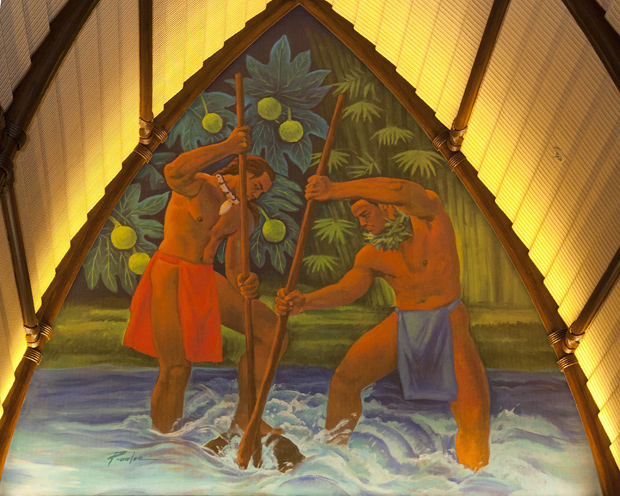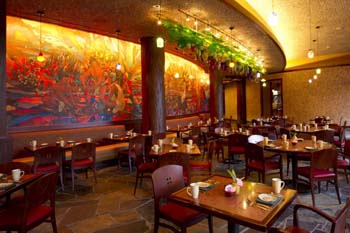
KO OLINA, Hawaii – The legacy of Hawaiian artistry is celebrated at Aulani, a Disney Resort & Spa, with one of the world’s largest private collections of contemporary Hawaiian art displayed throughout the resort.
“Every piece of art is part of a larger Hawaiian story, as told by Hawaiian artists,” said Joe Rohde, senior vice president and creative executive for Walt Disney Imagineering. More than 50 pieces decorate the hotel, including oil, acrylic and watercolor paintings; batik on silk; sculptures; wood carvings, kapa and bas relief.

Among the highlights:
- Three carved ki’i, or images, depicting the three brothers of the demi-god and folk hero Maui grace the resort’s entryway. (The word ki’i appears as “tiki” elsewhere in Polynesia.) , The ki’i are the combined works of three generations of local artists: master carvers Rocky Jensen, Pat Pine and Jordan Souza. Jensen, the celebrated carver who still works with a ko’i or adze, created the more traditional ki’i. Pine, the second oldest of the group, created a more modern and contemporary ki’i. Souza, the youngest contributor, celebrates the untold possibilities of the future in his work. By uniting their talents, these three artists have created a powerful work that is essentially timeless.
- Master carver Rocky Jensen also created three powerful ki’i at the entryway of the lobby. As guests enter, they are flanked by a ki’i representing masculinity on the right, and a ki’i representing femininity on the left. The two images pay respect to ancestors. The third piece, topped with the image of the ‘io, or Hawaiian hawk, represents the many generations of Hawaiian people who descended from these ancestors.
- The backdrop for the front desk will feature an impressive collage, “Rainbow Wall,” created by students in kindergarten through Grade 12 from across Hawaii. Each was asked to capture the essence of the islands in a photograph focusing on a single color. The 138 photos combine to exemplify the beauty of the islands – flowers, plants, animals and places – in brilliant shades of green, red, purple, pink, red, blue, orange and yellow. The mural was done in conjunction with the Hawaii Arts Alliance and the State of Hawaii, Creative Industries Division.
- The lobby mural by Martin Charlot is divided into masculine and feminine sections, outlining the works of men and women in traditional Hawaiian life. The painting hangs beneath kapa-style bands that run along the walls of the lobby, each representative of the sea, land and sky, further divided into masculine and feminine sides.
- The kapa bands that run along the walls of the lobby are the work of Dalani Tanahy. Each ban represents one of the three realms: land, sea and sky. These sections are further divided into distinct masculine and feminine sides. The masculine bands represent Kū, a god of many domains who often is associated with masculinity and male power. The feminine bands represent Hina, the goddess often associated with femininity and tranquility.
- “Pele and Hi’iaka” acrylic mural in the lobby’s transverse corridor arch by Doug Tolentino shows a trio of powerful gods. Pele, goddess of fire, sits in the canoe next to her favorite sister, Hi’iakaikapoliopele. Their brother, the god Kamao’oali’i, uses his shark form to serve as their guide and protector. Together, the trio makes a voyage across the seas. Hi’iakaikapoliopele means “Hi’iaka in the bosom of Pele”; when Pele and her clan made the original voyage to Hawai’i from Kahiki, Hi’aka was unborn, existing only as an unhatched egg and held close to her heart.
- At the other end of the lobby corridor, Doug Tolentino’s painting of “Kanaloa and Kāne” portrays two of the major gods of Hawaiian beliefs. Mo’olelo, or stories, tell of the two venturing across Oahu and creating many natural water sources along the way. Kanaloa, ever on the search for a source of water to mix awa with, asks Kāne to pierce the land with his digging stick and bring forth life-giving water. From their adventures come Oahu’s freshwater springs.
- Also in the lobby, a map of Oahu was created and given to Aulani by the children of nearby Nānāikapono Elementary School with the guidance of local artist and educator Meleanna Meyer. Students were asked to illustrate pictures of their favorite places on the island, and the images were placed on the map – a testament to Hawaii’s keiki, or children, and their strong sense of place.
- Near the grand staircase that leads to Makahiki – The Bounty of the Island restaurant, local artist Mark Chai created a series of sculptures that capture the sense of play that is so important to Hawaiian cultures. One sculpture is of papa holua, or Hawaiian sled, for racing down mountainsides. Another sculpture is inspired by the Hawaiian board game similar to checkers, called kōnan. A third is a lupe, or Hawaiian kite. Each sculpture is made from recycled materials, emphasizing the Hawaiian aloha ‘āina, or love of land.
- In the entry to Makahiki – The Bounty of the Islands restaurant, artists Butch Helemano and James Rumford collaborated to convey the story of the Makahiki season of peace, play and renewal. (The “Makahiki season” was the ancient Hawaiian New Year festival.) Rumford sketched the designs and wrote texts for Helemano’s wood carvings that illustrate the sights and events of the Makahiki season. One carving shows an ahupua’a, a stone pillar capped with the image of a boar that marks the boundaries between island districts. (Offerings were placed on the pillars during Makahiki.)
- At Nā Pua Place, local painter Brooke Parker gives a clear view of the traditional ahupua’a, the land divisions that run from the mountains to the sea. By dividing the islands into these slices of land, Hawaiians of old made sure that every community had access to all the varied resources the island had to provide. Farmers of the uplands would share their crops with the fishermen of the seaside and receive gifts in return. Aulani is designed like an ahupua’a, with the lobby as mauka, or mountainside, and the Waikolohe Valley below running out to the sea.
- On the exterior of the two towers, bas relief sculptures rise 15 stories. One, by Carl Pao, takes a Hawaiian oli – an aloha or welcome chant – composed by fellow artist and musician Doug Tolentino and interprets the words into a visual design. The chant speaks about the rising and setting of the sun and moon – and one bas relief faces towards the West, the other towards the East. Traditional Hawaiian concepts of balance between masculine and feminine, night and day, and sun and moon are echoed.
- Also on the building exteriors, bas relief sculptures by Harinani Orme show an outrigger canoe on the open ocean, a vital mode of transportation in day-to-day life in Hawaiian history. Celestial bodies in the sky above the canoe represent the importance of the sun and moon as navigational tools. Another Orme bas relief is a tribute to the goddess Hina – a kind and nurturing figure known and beloved throughout Polynesia – towering over the Waikolohe Valley. Orme depicts Hina with her kapa tools laid out before her. A third bas relief by Orme stands at the end of the Waikolohe Valley opposite the Hina bas relief depicting Hina’s son, the demi-god Māui. Orme layers detail after detail of Māui’s exploits in the mural. One tale has Māui lassoing the sun to slow the speed of its journey across the sky,
 lengthening the days. Another has Māui flying the first kite. The most popular story details his attempt to capture a strong and magical fish which could unite the islands.
lengthening the days. Another has Māui flying the first kite. The most popular story details his attempt to capture a strong and magical fish which could unite the islands.
###
About Aulani, a Disney Resort & Spa
Uniquely designed for families and inspired by the wonders and traditions of Hawaii, Aulani, a Disney Resort & Spa, is a family paradise with a touch of magic. Aulani offers kids, adults and families Hawaiian vacation experiences with a special magic that only Disney can create. Delightful rooms and spacious Disney Vacation Club villas, a perfect location on a beautiful beachfront lagoon, and renowned Disney service and enchanting entertainment let dreamers of every age savor their time together on Hawaii as never before.
